Bond LSC Research

Oct. 10, 2016
Expert Comment: How science made the “three-person” baby possible
Stock image via iStock By Jennifer Lu | Bond LSC A new in-vitro fertilization technique that uses genetic material from three persons made the news last week following the announcement of the successful birth of a now five-month-old baby boy. The process allowed the mother, who had a rare mitochondrial disease known as Leigh Syndrome, to have a child without passing her faulty mitochondrial genes. The nucleus from the mother’s egg was inserted into a prepared donor egg that had healthy mitochondria to make a cybrid, or cytoplasmic hybrid, egg that was then fertilized.
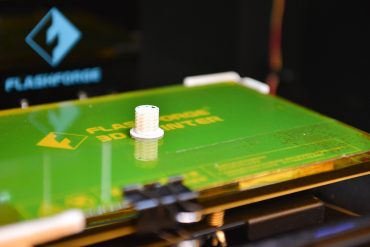
Sep. 28, 2016
An enzymatic future
Inter-departmental MU team aims to improve enzyme use and recovery for spectrum of industrial, medical and military applications By Phillip Sitter | Bond LSC A mostly-finished cylindrical bio-reactor site sits in a 3D printer after the printing has stopped. With a 3D printer in-house, Chung-Ho Lin said that the inter-departmental team he is part of can generate four or five different prototypes a day to test in their bio-reactor model, instead of having to order from different fabrication companies. A basic printer like this used to cost $8,000, but within the last year prices dropped to…

Sep. 2, 2016
Building blocks of life in the lab could revolutionize life for us all
NASA, NIH-funded work seeks to understand bio-chemical mechanisms of life on Earth, and among the stars By Phillip Sitter | Bond LSC Donald Burke-Agüero stands in his office in Bond LSC, holding a model of an RNA protein structure. Burke-Agüero studies the bio-chemical functions of RNA, and how those functions might be able to be artificially designed or replicated. | Phillip Sitter, Bond LSC Any child obsessed with Legos knows the fun of creation bound only by imagination and the size or variety of the blocks within their pile. For some scientists, that spirit extends…
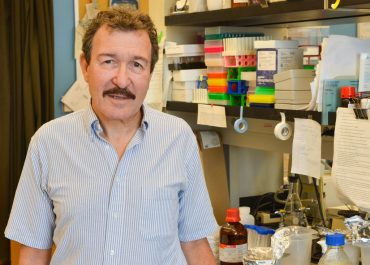
Aug. 4, 2016
Standing out through saliva
Bond LSC scientist internationally recognized for work on salivary glands and autoimmune disorders By Phillip Sitter | Bond LSC You might not think too highly of spit, but you would quickly regret not having any. People with Sjögren’s syndrome suffer chronic dry mouth and eyes from an overzealous immune system that attacks salivary and tear ducts, causing serious health issues. Gary Weisman’s research might hold the key to understanding and managing this immune response, leading to effective treatment or even prevention of this ailment. For this, the International Association of Dental Research, or IADR, awarded him the 2016 Distinguished Scientist Award…
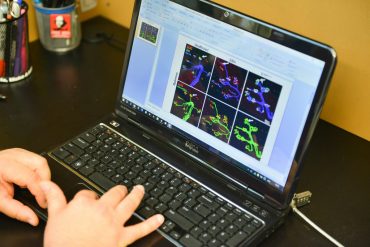
July 21, 2016
Finding hope by fixing a gene
Lorson lab publishes research on a new therapeutic path to help treat spinal muscular atrophy By Phillip Sitter | MU Bond Life Sciences Center Erkan Osman shows iImages of neuro-muscular junctions. Osman, a post-doctoral fellow in Chris Lorson’s lab, co-authored research in the journal Molecular Therapy that details work in binding a synthetic nucleic acid to a normally useless motor neuron backup gene to help treat spinal muscular atrophy. | photo by Phillip Sitter, Bond LSC Imagine you are forced to jump out of an airplane. Luckily, you find a parachute that even…
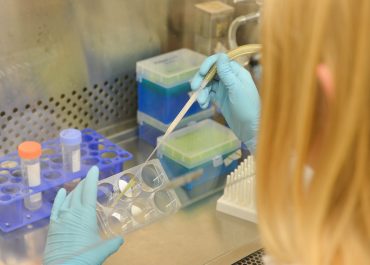
July 19, 2016
How does Zika move from mother to child?
Scientists use placental cells in lab to study virus By Phillip Sitter | MU Bond Life Sciences Center Megan Sheridan, an MU grad student, removes the base solution from a demonstrated sample of stem cells that will be grown into placental cells for study of Zika virus. Within four days of exposure to the correct hormones, the stem cells express genes of placental cells, and within another day start producing placental hormones. The cells are infected with Zika at day four to ensure maximum measurable interaction, as the stem cells naturally die in…
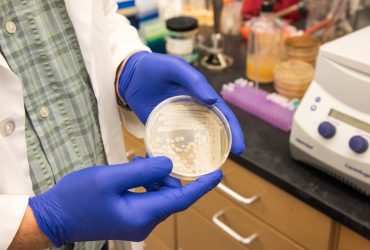
July 6, 2016
Anthrax: villain or misunderstood?
Stewart holds a different colony of anthrax in his lab. Stewart’s work with anthrax and other similar organisms focuses on understanding the tough protein shell of the bacteria’s spores that enable the pathogen to survive in soil for extended periods of time, even hundreds of years. | photo by Phillip Sitter, Bond LSC By Phillip Sitter | MU Bond Life Sciences Center For a tiny spore, anthrax holds a lot of danger and promise. If you found yourself wondering about more than its safety in the lab, we have a answers to a few persistent…
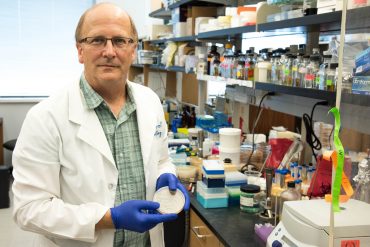
June 29, 2016
Under the hood
The safety behind studying deadly disease By Phillip Sitter | MU Bond Life Sciences Center George Stewart, McKee Professor of Microbial Pathogenesis and Chair of Veterinary Pathobiology holds up a colony of Bacillus anthracis in his lab. The strain of anthrax he holds is non-virulent, and is therefore safe to handle under BSL-2 precautions as opposed to BSL-3 for virulent strains that cause disease in humans. | photo by Phillip Sitter, Bond LSC You’ve seen it before in the movies. Sweaty scientists put on their full-body, spacesuit-like get-ups to stave off a potentially extinction-level…
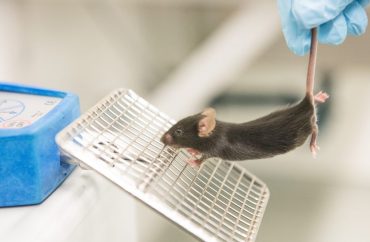
May 23, 2016
One step closer from mice to men
Gene therapy treating the neurodegenerative disease, SMARD1, shows promising results in mice studies. Shababi uses an instrument to measure grip strength in the forelimbs of mice. Healthy mice are able to cling on with a stronger grip than SMARD1 mice. | photo by Jennifer Lu, Bond LSC Monir Shababi was confident her experiments treating a rare genetic disease would yield positive results before she even ran them. Scientists had success with a similar degenerative neuromuscular disease, so she had every expectation their strategy would work just as well in her mice. Monir…
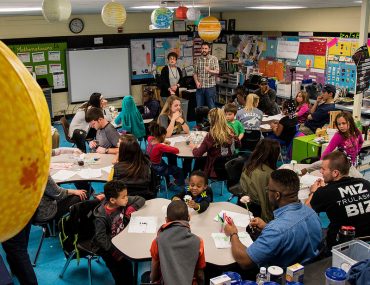
May 2, 2016
Learning on Different Levels
New outreach program teaches CAFNR students to make plant science knowledge accessible to a younger audience Written by Stephen Schmidt | Science Writer in the College of Agriculture, Food and Natural Resources Although abundant light was shining through the windows, it was the quiet before the storm. Andrew Ludwig, a University of Missouri sophomore majoring in plant sciences, surveyed the small tables and chairs spread out before him in the laboratory of the Benton STEM Elementary School on a recent Monday afternoon. He sifted through his notes. He was ready, even though it was his first time stepping foot…
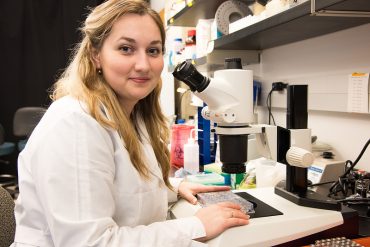
April 5, 2016
Gres receives Von Schwedler Prize
Work on HIV capsid proteins earns prestigious retrivology award Anna Gres studies HIV capsid protein using X-ray crystallography. She recently won the 2016 von Schwedler Prize, which awards her $1,200 and gives her the oppportunity to speak this spring at the Cold Spring Harbor Retrovirus Meeting, one of the largest retroviral research conferences in the world. | photo by Roger Meissen, Bond LSC Science is all about structure in the work of Anna Gres. For the past four years, she’s looked closely at one HIV protein to figure out its shape in order to stop the virus.
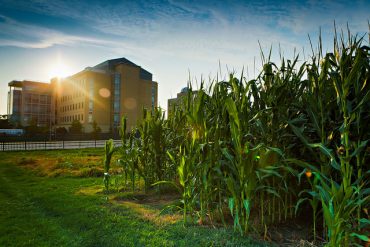
March 30, 2016
MU Scientists Fighting World Hunger
By Bobby Remis | MU Bond Life Sciences Center Sanborn Field, University of Missouri | photo by Kyle Spradley In the years to come, climate change and population growth will drastically alter the world around us, impacting farmland and the way we grow food. Scott Peck, associate professor of biochemistry, studies how plants perceive and respond to changes in their environment. New research from an interdisciplinary team at the University of Missouri is hoping to curb the decrease in food production due to climate change by studying the roots of corn…